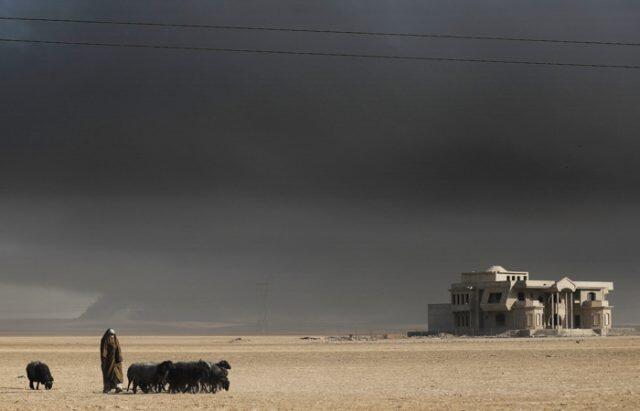The battle to retake Mosul from the Daesh group is leaving a legacy of environmental damage and health risks that will pose dangers to people for years to come.
Iraqis have already paid the initial price from burning oil wells and a sulphur factory that Daesh set alight south of Mosul, Iraq’s last militant-held city which is the target of a major military operation launched two months ago.
The fires, combined with water pollution and the potentially toxic remains of destroyed buildings, military equipment and munitions, will also present longer-term threats to people in areas around and inside Mosul.
“We are concerned about how the pollution will affect the health of local populations and negatively impact their capacity to rebuild quality, sustainable livelihoods within those affected areas,” said Jenny Sparks of the International Organization for Migration.
A United Nations report on environmental and health risks in the Mosul area said that “hundreds of people were treated for exposure to chemicals, and millions are exposed to soot and gases from the burning oil wells”.
“The events are occurring in an already environmentally degraded region, threatened by substantial environmental legacy risk from previous conflicts, coupled with serious desertification and land degradation primarily caused by unsustainable agricultural practices,” the report said.
Daesh set fire to oil wells before the Qayyarah area was recaptured by Iraqi forces in August, and these have burned for months, turning sheep that graze in the area black with soot.
“We can’t sell our sheep any more. We have had some sheep die, other times people won’t buy them because they look black,” said Jaber, a 16-year-old shepherd.
Iraqi civil defence forces have been battling the Qayyarah fires, and while they have extinguished some, others are still burning.
Daesh also set fire to the Mishraq sulphur plant south of Mosul, and while the blaze was eventually put out, it had already blanketed nearby areas with a haze of smoke that caused respiratory problems for those who inhaled it.
However, the aftermath of a 2003 fire at the same plant offers some cause for optimism, according to the UN report.
“Even though the vegetation and crops had been badly damaged by the fire, natural recovery was advancing well two years later,” it said.
Houses and other buildings damaged or destroyed by air strikes and shelling also pose a risk to civilians trying to return and rebuild their homes.
“Crushed building materials contain harmful substances, pulverized cement, household wastes and chemicals which can cause exposure hazards to civilians and people dealing with the rubble,” the UN report said.
The destruction of ammunition and weapons depots can also “leave a toxic footprint”, while “destroyed military material such as tanks and armored vehicles often contains various toxic materials”, it said.
Water pollution associated with the conflict is another potential problem, according to Eric Solheim, the head of the United Nations Environment Program.
“The dumping of bodies, hazardous materials and oil into water sources have all been reported and are major causes of concern,” Solheim said.
Inadequate disposal of waste also poses risks, the UN said.
“Collapse of environmental governance can further lead to accumulation of solid household, medical and industrial waste, and if not dealt with properly, can result in increased burning of solid waste and resulting environmental health risks, or the outbreak of communicable diseases,” it said.
Source: AFP











